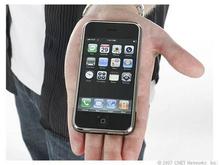
The Apple iPhone: 2007, meet 2017
I know that it’s popular to hate on the iPhone and spread predictions of its impending doom, but what surprises me isn’t how popular the iPhone is now, but that it survived the first couple of years to become the influential cash-generating machine that it has become.
I’m just going to come out and say it: The original iPhone was junk. I know, that’s a scandalous thing to say, but to say otherwise is to do a disservice to the memories of the awesome handsets of the time. Call quality was terrible. It didn’t support multimedia messaging. And data speeds were slow even for 2007, because Apple chose not to support 3G.
It wasn’t even a phone first. You had to fire up the Phone app — although we didn’t call it an app back in the day — to make calls, which seemed strange for a phone.
It was also pretty awful as an iPod. Four gigabytes of storage on the base model really didn’t go that far (and Apple knew this, because it binned it in September 2007), and Bluetooth 2.0 didn’t support stereo.
The iOS operating system — it was called iPhone OS back then — was also very lacking, missing even basic features such as the ability to cut/copy/paste (we had to wait until iOS 3.0 for this feature to finally appear). There was also no support for third-party apps, and Apple relied heavily on Google to make up the shortfall in its services (of the 16 “apps” that appeared on the iPhone’s screen, the Maps app used Google Maps, and there was a built-in YouTube app).
It’s not until you go back to an early iPhone or iPod touch that you really appreciate how far along iOS has come. Back then, even platforms such as Windows Mobile had a massive features advantage over what Apple had to offer.
So, how did the iPhone survive?
While some would point to the “Apple effect,” and how after the iPod there was huge consumer interest in the company, and that it was this that propelled the iPhone into the stratosphere, I’m skeptical. Someone who was happy with their iPod doesn’t automatically become the sort of person who was going to shell out hundreds of dollars for an iPhone that’s tied to a contract.
Nah, I don’t think the success of the iPhone was down to the iPod.
What I think made the iPhone what it is today was a combination of two things.
First, excellent design. Yes, a slab that’s mostly screen seems obvious, but it’s clear that Apple put a lot of engineering effort into making the iPhone that way, and that meant making unpopular compromises, such as making the battery non-removable.
A testament to just how good the initial iPhone design was is how little it’s changed. Yes, the phone’s got bigger and thinner and such, but the overall design remains the same. In fact, the biggest change Apple made to the design outside of the bigger screen has been moving the headphone jack. Ii started out on the top, then moved to the bottom with the iPhone 5, and was eliminated with the iPhone 7. Outside of that, some materials changes, tweaks to the dimensions, and swapping the 30-pin port for Lightning, the original iPhone design has survived the test of time.
Another factor in the iPhone’s success was the quality of the display. The 3.5-inch 480×320 touchscreen display wasn’t just nice to look at, it was really smooth to use — something that couldn’t be said of most touchscreens in 2007. Apple cut a lot of corners with the original iPhone, but not when it came to the display, and that was a clever move because it was the bit that people interacted with the most.
I truly believe that if the display had been poor, the iPhone would have sunk into oblivion like Apple’s other foray into phones, the truly execrable Motorola Roker E1.
The other thing that made the iPhone great was the browser. I trash-talk Safari a lot, but back in 2007, mobile browsers ranged from terrible to really, really terrible. Safari was a breath of fresh air, and turned mobile browsing from being a chore to a pleasure. It’s impossible to describe how bad mobile browsing was before the iPhone. You just had to be there to appreciate just how easy web browsing on the iPhone was compared to other devices.
It was a total game-changer, and it was amazing how much real browsing you could do on a 3.5-inch display (despite the painfully slow cellular speeds).
Then there was the price-cut. Originally, the 4GB iPhone sold for $399, and the 8GB version for $599, but in less than three months, Apple discontinued the 4GB version, while at the same time dropping the price of the 8GB iPhone by $200, with early adopters getting $100 store credit (but only after venting their spleen at the late Steve Jobs).
So, some aspects of the original iPhone were terrible, but what was good was not only very, very good, but it also upended the entire mobile device ecosystem, and completely changed the smartphone for the next decade with such force that almost every other smartphone looks (and, as much as possible, feels) like the iPhone.
But no matter how much the competition tries to emulate the iPhone, they just can’t quite capture what makes the iPhone the success it has become.


